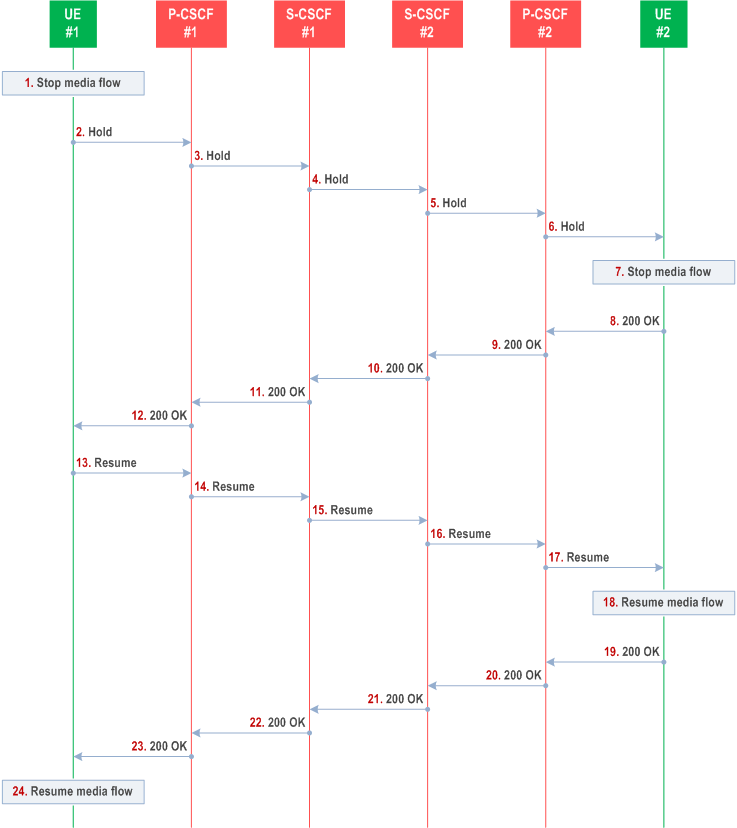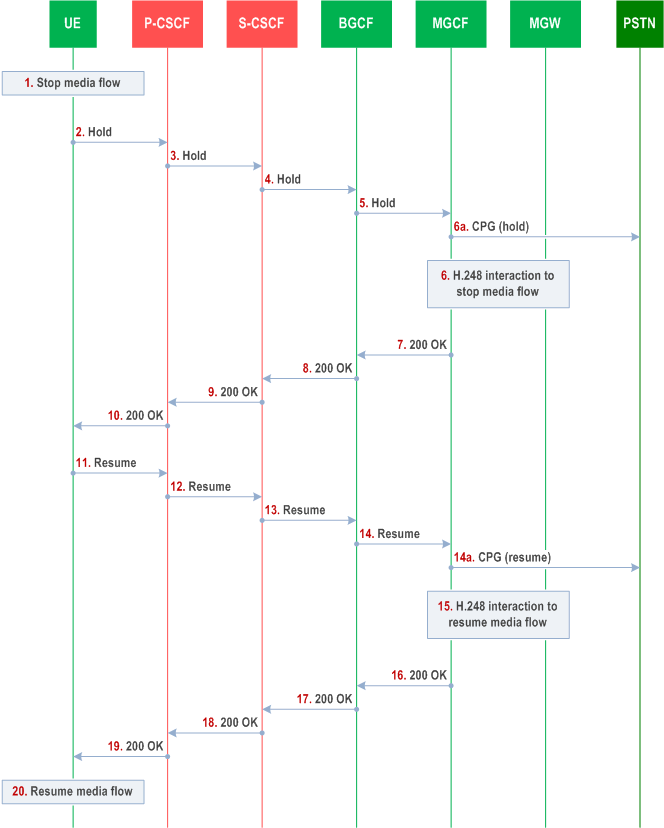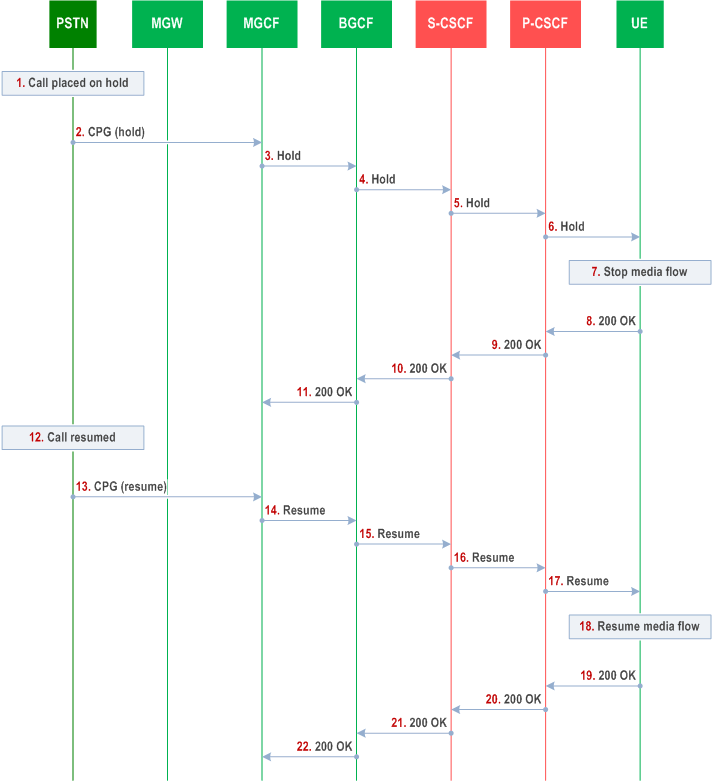Content for TS 23.228 Word version: 19.1.0
1…
3…
4…
4.2.4…
4.3…
4.4…
4.13…
4.16…
5…
5.2…
5.3…
5.4…
5.4.7…
5.4.8…
5.4a…
5.5…
5.5.3…
5.6…
5.6.3…
5.7…
5.7.3…
5.7.5…
5.7.8…
5.8…
5.10…
5.11…
5.11.3…
5.11.3.3
5.11.3.4
5.11.4…
5.11.5…
5.11.5.3…
5.11.6…
5.12…
5.16…
5.16.2…
5.19…
5.20…
A…
E…
E.2.2…
G…
G.5…
H
I…
J…
K…
L…
M…
M.3…
N…
P…
Q…
Q.2.5…
R…
S…
T…
U…
U.2…
V…
W…
X…
Y…
Z…
AA…
AA.3…
AB…
AC…
AC.7…
AC.7.2…
AC.7.2.2
AC.7.2.3…
AC.7.4…
AC.7.9…
AC.7.9.3…
AC.7.10…
AC.7.10.4.2…
AC.9…
AC.10…
AC.11…
AD…
AE…
AF…
AG…
5.11 Procedures to enable enhanced multimedia services
5.11.1 Session Hold and Resume Procedures
5.11.1.0 General
5.11.1.1 Mobile-to-Mobile Session Hold and Resume Procedures
5.11.1.2 Mobile-initiated Hold and Resume of a Mobile-PSTN Session
5.11.1.3 PSTN-initiated Hold and Resume of a Mobile-PSTN Session
5.11.2 Procedures for anonymous session establishment
5.11.2.0 General
5.11.2.1 Signalling requirements for anonymous session establishment
5.11.2.2 Bearer path requirements for anonymous session establishment
...
...
5.11 Procedures to enable enhanced multimedia services p. 159
5.11.1 Session Hold and Resume Procedures p. 159
5.11.1.0 General |R6| p. 159
This clause gives information flows for the procedures for placing sessions on hold that were previously established by the mechanisms of clause 5.4, clause 5.5, clause 5.6, and clause 5.7, and resuming the session afterwards. Two cases are presented: mobile-to-mobile (UE-UE), and a UE-initiated hold of a UE-PSTN session.
For a multi-media session, it shall be possible to place a subset of the media streams on hold while maintaining the others.
These procedures do not show the use of optional I-CSCFs. If an I-CSCF was included in the signalling path during the session establishment procedure, it would continue to be used in any subsequent flows such as the ones described in this clause.
5.11.1.1 Mobile-to-Mobile Session Hold and Resume Procedures p. 159
An IMS session was previously established between an initiating UE and a terminating UE. Each of these UEs has an associated P-CSCF, and a S-CSCF assigned in their home network. The procedures are independent of whether the P-CSCFs are located in the home or visited networks. Therefore there is no distinction in this clause of home network vs. visited network.
The hold and resume procedures are identical whether the UE that initiated the session also initiates the session-hold, or whether the UE that terminated the session initiates the session-hold.
When a media stream has been placed on hold, it shall not be resumed by any endpoint other than the one that placed it on hold.
The procedures for placing a media stream on hold, and later resuming the media stream, are as shown in the following information flow:

Information flow procedures are as follows:
Step 1.
UE#1 detects a request from the user to place a media stream on hold. UE#1 stops sending the media stream to the remote endpoint, but keeps the resources for the session reserved.
Step 2.
UE#1 sends a Hold message to its proxy, P-CSCF#1.
Step 3.
P-CSCF#1 forwards the Hold message to S-CSCF#1.
Step 4.
S-CSCF#1 forwards the Hold message to S-CSCF#2.
Step 5.
S-CSCF#2 forwards the Hold message to P-CSCF#2.
Step 6.
P-CSCF#2 forwards the Hold message to UE#2.
Step 7.
UE#2 stops sending the media stream to the remote endpoint, but keeps the resources for the session reserved.
Step 8.
UE#2 acknowledges receipt of the Hold message with a 200-OK final response, send to P-CSCF#2.
Step 9.
P-CSCF#2 forwards the 200 OK final response to S-CSCF#2.
Step 10.
S-CSCF#2 forwards the 200 OK final response to S-CSCF#1.
Step 11.
S-CSCF#1 forwards the 200 OK final response to P-CSCF#1.
Step 12.
P-CSCF#1 forwards the 200 OK final response to UE#1.
Step 13.
UE#1 detects a request from the user to resume the media stream previously placed on hold. UE#1 sends a Resume message to its proxy, P-CSCF#1.
Step 14.
P-CSCF#1 forwards the Resume message to S-CSCF#1.
Step 15.
S-CSCF#1 forwards the Resume message to S-CSCF#2.
Step 16.
S-CSCF#2 forwards the Resume message to P-CSCF#2.
Step 17.
P-CSCF#2 forwards the Resume message to UE#2.
Step 18.
UE#2 resumes sending the media stream to the remote endpoint.
Step 19.
UE#2 acknowledges receipt of the Resume message with a 200-OK final response, sent to P-CSCF#2.
Step 20.
P-CSCF#2 forwards the 200 OK final response to S-CSCF#2.
Step 21.
S-CSCF#2 forwards the 200 OK final response to S-CSCF#1.
Step 22.
S-CSCF#1 forwards the 200 OK final response to P-CSCF#1.
Step 23.
P-CSCF#1 forwards the 200 OK final response to UE#1.
Step 24.
UE#1 resumes sending the media stream to the remote endpoint.
5.11.1.2 Mobile-initiated Hold and Resume of a Mobile-PSTN Session p. 161
An IMS session was previously established between an initiating UE and a MGCF acting as a gateway for a session terminating on the PSTN, or between an initiating MGCF acting as a gateway for a session originating on the PSTN to a terminating UE. The UE has an associated P-CSCF, an S-CSCF assigned in its home network, and a BGCF that chooses the MGCF. The procedures are independent of whether the P-CSCF is located in the subscriber's home or visited network. Therefore there is no distinction in this clause of home network vs. visited network.
The session hold and resume procedure is similar whether the UE initiated the session to the PSTN, or if the PSTN initiated the session to the UE. The only difference is the optional presence of the BGCF in the case of a session initiated by the UE. Note that the BGCF might or might not be present in the signalling path after the first INVITE is routed.
The procedures for placing a media stream on hold, and later resuming the media stream, are as shown in the following information flow:

Information flow procedures are as follows:
Step 1.
UE detects a request from the user to place a media stream on hold. UE#1 stops sending the media stream to the remote endpoint, but keeps the resources for the session reserved.
Step 2.
UE sends a Hold message to its proxy, P-CSCF.
Step 3.
P-CSCF forwards the Hold message to S-CSCF.
Step 4.
S-CSCF forwards the Hold message to BGCF.
Step 5.
BGCF forwards the Hold message to MGCF.
Step 5a.
MGCF sends a CPG(hold) in order to express that the call has been placed on hold.
Step 6.
MGCF initiates a H.248 interaction with MGW instructing it to stop sending the media stream, but to keep the resources for the session reserved.
Step 7.
MGCF acknowledges receipt of the Hold message with a 200-OK final response, send to BGCF.
Step 8.
BGCF forwards the 200-OK to the S-CSCF.
Step 9.
S-CSCF forwards the 200 OK final response to P-CSCF.
Step 10.
P-CSCF forwards the 200 OK final response to UE.
Step 11.
UE detects a request from the user to resume the media stream previously placed on hold. UE sends a Resume message to its proxy, P-CSCF.
Step 12.
P-CSCF forwards the Resume message to S-CSCF.
Step 13.
S-CSCF forwards the Resume message to BGCF.
Step 14.
BGCF forwards the Resume message to MGCF.
Step 14a.
MGCF sends a CPG(resume) in order to resume the call.
Step 15.
MGCF initiates a H.248 interaction with MGW instructing it to resume sending the media stream.
Step 16.
MGCF acknowledges receipt of the Resume message with a 200-OK final response, sent to BGCF.
Step 17.
BGCF forwards the 200 OK final response to the S-CSCF.
Step 18.
S-CSCF forwards the 200 OK final response to P-CSCF.
Step 19.
P-CSCF forwards the 200 OK final response to UE.
Step 20.
UE resumes sending the media stream to the remote endpoint.
5.11.1.3 PSTN-initiated Hold and Resume of a Mobile-PSTN Session |R6| p. 163
An IMS session was previously established between an initiating UE and a MGCF acting as a gateway for a session terminating on the PSTN, or between an initiating MGCF acting as a gateway for a session originating on the PSTN to a terminating UE. The UE has an associated P-CSCF, an S-CSCF assigned in its home network, and a BGCF that chooses the MGCF. The procedures are independent of whether the P-CSCF is located in the subscriber's home or visited network. Therefore there is no distinction in this clause of home network vs. visited network.
The session hold and resume procedure is similar whether the UE initiated the session to the PSTN, or if the PSTN initiated the session to the UE. The only difference is the optional presence of the BGCF in the case of a session initiated by the UE. Note that the BGCF might or might not be present in the signalling path after the first INVITE is routed.
The following information flow shows the procedures, where the session is set on hold from the PSTN side:

Information flow procedures are as follows:
Step 1.
The call is placed on hold in the PSTN.
Step 2.
The MGCF receives a CPG (hold) from the PSTN, which indicates that the call has been placed on hold.
Step 3.
MGCF sends a Hold message to BGCF.
Step 4.
BGCF forwards the Hold message to S-CSCF.
Step 5.
S-CSCF forwards the Hold message to P-CSCF.
Step 6.
P-CSCF forwards the Hold message to the UE.
Step 7.
UE stops sending the media stream to the remote endpoint, but keeps the resources for the session reserved.
Step 8.
The UE acknowledges receipt of the Hold message with a 200-OK final response, send to P-CSCF.
Step 9.
P-CSCF forwards the 200-OK final response to S-CSCF.
Step 10.
S-CSCF forwards the 200 OK final response to BGCF.
Step 11.
BGCF forwards the 200 OK final response to MGCF.
Step 12.
The call is resumed in the PSTN.
Step 13.
MGCF receives a CPG (resume) request from the PSTN, which indicates that the call is resumed.
Step 14.
MGCF sends a resume message to BGCF.
Step 15.
BGCF forwards the Resume message to S-CSCF.
Step 16.
S-CSCF forwards the Resume message to P-CSCF.
Step 17.
P-CSCF forwards the Resume message to UE.
Step 18.
UE resumes sending the media stream to the remote endpoint.
Step 19.
UE acknowledges receipt of the Resume message with a 200-OK final response, sent to P-CSCF.
Step 20.
P-CSCF forwards the 200 OK final response to the S-CSCF.
Step 21.
S-CSCF forwards the 200 OK final response to BGCF.
Step 22.
BGCF forwards the 200 OK final response to MGCF.
5.11.2 Procedures for anonymous session establishment p. 165
5.11.2.0 General |R6| p. 165
This clause gives information flows for the procedures for an anonymous session. However, sessions are not intended to be anonymous to the originating or terminating network operators.
The purpose of the mechanism is to give an IMS user the possibility to withhold certain identity information as specified in RFC 3323 and RFC 3325.
The privacy mechanism for IMS networks shall not create states in the CSCFs other than the normal SIP states.
IMS entities shall determine whether they are communicating with an element of the same Trust Domain for Asserted Identity or not as described in RFC 3325.
5.11.2.1 Signalling requirements for anonymous session establishment p. 165
The user shall be able to request that her identity information is not revealed to the terminating party.
If the originating user requests the session to be anonymous, the terminating side must not reveal any identity or signalling routing information to the destination endpoint. The terminating network should distinguish at least two cases, first where the originator intended the session to be anonymous, and second where the originator's identity was deleted by a transit network.
5.11.2.2 Bearer path requirements for anonymous session establishment p. 165
Procedures for establishment of an anonymous bearer path are not standardised in this release.